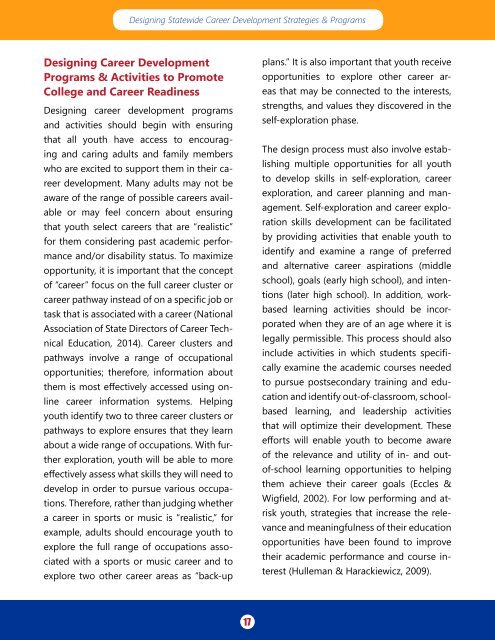Designing Statewide Strategies & Programs
DesigningStatewideCareerDevelopmentStrategiesProgramsPub_0
DesigningStatewideCareerDevelopmentStrategiesProgramsPub_0
Create successful ePaper yourself
Turn your PDF publications into a flip-book with our unique Google optimized e-Paper software.
<strong>Designing</strong> <strong>Statewide</strong> Career Development <strong>Strategies</strong> & <strong>Programs</strong><br />
<strong>Designing</strong> Career Development<br />
<strong>Programs</strong> & Activities to Promote<br />
College and Career Readiness<br />
<strong>Designing</strong> career development programs<br />
and activities should begin with ensuring<br />
that all youth have access to encouraging<br />
and caring adults and family members<br />
who are excited to support them in their career<br />
development. Many adults may not be<br />
aware of the range of possible careers available<br />
or may feel concern about ensuring<br />
that youth select careers that are “realistic”<br />
for them considering past academic performance<br />
and/or disability status. To maximize<br />
opportunity, it is important that the concept<br />
of “career” focus on the full career cluster or<br />
career pathway instead of on a specific job or<br />
task that is associated with a career (National<br />
Association of State Directors of Career Technical<br />
Education, 2014). Career clusters and<br />
pathways involve a range of occupational<br />
opportunities; therefore, information about<br />
them is most effectively accessed using online<br />
career information systems. Helping<br />
youth identify two to three career clusters or<br />
pathways to explore ensures that they learn<br />
about a wide range of occupations. With further<br />
exploration, youth will be able to more<br />
effectively assess what skills they will need to<br />
develop in order to pursue various occupations.<br />
Therefore, rather than judging whether<br />
a career in sports or music is “realistic,” for<br />
example, adults should encourage youth to<br />
explore the full range of occupations associated<br />
with a sports or music career and to<br />
explore two other career areas as “back-up<br />
plans.” It is also important that youth receive<br />
opportunities to explore other career areas<br />
that may be connected to the interests,<br />
strengths, and values they discovered in the<br />
self-exploration phase.<br />
The design process must also involve establishing<br />
multiple opportunities for all youth<br />
to develop skills in self-exploration, career<br />
exploration, and career planning and management.<br />
Self-exploration and career exploration<br />
skills development can be facilitated<br />
by providing activities that enable youth to<br />
identify and examine a range of preferred<br />
and alternative career aspirations (middle<br />
school), goals (early high school), and intentions<br />
(later high school). In addition, workbased<br />
learning activities should be incorporated<br />
when they are of an age where it is<br />
legally permissible. This process should also<br />
include activities in which students specifically<br />
examine the academic courses needed<br />
to pursue postsecondary training and education<br />
and identify out-of-classroom, schoolbased<br />
learning, and leadership activities<br />
that will optimize their development. These<br />
efforts will enable youth to become aware<br />
of the relevance and utility of in- and outof-school<br />
learning opportunities to helping<br />
them achieve their career goals (Eccles &<br />
Wigfield, 2002). For low performing and atrisk<br />
youth, strategies that increase the relevance<br />
and meaningfulness of their education<br />
opportunities have been found to improve<br />
their academic performance and course interest<br />
(Hulleman & Harackiewicz, 2009).<br />
17


